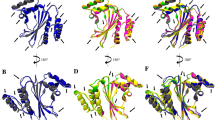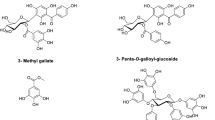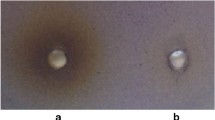Abstract
Phyllanthus emblica is a traditional medicinal plant that is endowed with curative properties including anti-bacterial, anti-fungal, anti-viral, and analgesic properties. Bacteria make use of cell–cell signaling system known as quorum sensing (QS) and respond to their own population. In most gram-negative bacteria, the transcriptional regulators belonging to the Lux R protein play a crucial role in the QS mechanism by detecting the presence of signaling molecules known as N-acyl homoserine lactones (AHLs). In this present work, the anti-quorum sensing activity of Phyllanthus emblica was evaluated against Pseudomonas aeruginosa. Anti-quorum sensing efficacy of Phyllanthus emblica was estimated with reference to QS bio-monitoring strain Chromobacterium violaceum. The binding efficacy of the phytochemicals of Phyllanthus emblica against CviR protein from Chromobacterium violaceum and LasR protein from Phyllanthus emblica were studied.
Similar content being viewed by others
Avoid common mistakes on your manuscript.
Introduction
Globally, in the last few decades, the emergence and widespread of antimicrobial-resistant, antimicrobial drug-resistant strains of Pseudomonas spp. and Staphylococcus spp. become the alarming situation of greater public health concern [1,2,3]. P. aeruginosa is mainly responsible for postoperative wound infections and is more prevalent in most of the hospital-acquired infections [4,5,6].
In general, antibiotics are used to control these microbial infections by inhibiting their growth. However, the continuous usage and misuse of antibiotic therapy led to the emergence of multi-drug resistant strains to the tolerance against a broad spectrum of available antibiotics [7]. The development of these multiple drug-resistant bacteria has forced the scientists to search for new antibacterial agents that have become the main concern [8]. Though the search for new antimicrobial substances has resulted in novel antimicrobial chemotherapeutic agents as synthetic drugs from various sources, the higher cost production and its adverse effects have limited its usages when compared to plant-derived drugs [9,10,11]. Thus the search for novel anti-pathogenic agents has increased the focus on the potential compounds from plant sources that are widespread across the globe. The increase in the search for therapeutic compounds from plants is based on a fact that plants continue to survive with high bacterial density in an environment and might possess protective means against infections. Thus in recent years, the extracts from plants and the knowledge of medicinal plants have gained the attentions of many pharmaceutical industries [12,13,14].
Cell–cell signaling systems known as QS are used by bacteria to communicate with each other and respond to their own population. In gram-negative bacteria, the LuxR, a transcriptional regulator protein, plays a central role in the QS mechanism to detect AHLs as signalling molecules [15, 16].
In this work, the anti-quorum sensing activity of P. emblica was evaluated against P. aeruginosa. Anti-quorum sensing efficacy of P. emblica was estimated with reference to QS bio-monitoring strain C. violaceum. The binding efficacy of the phytochemicals against CviR Protein from C. violaceum and LasR protein from P. aeruginosa were studied.
Methodology
The 3D models of P. aeruginosa LasR (PDB ID: 2UV0) and CviR from C. violaceum (PDB ID: 3QP5) were retrieved from the PDB database and the conserved residues were determined with other LuxR family protein by using ClustalW at the EBI (European Bioinformatics Institute) server [17].
Ligands
The principle compounds of P. emblica were retrieved from Duke Ethnobotanical database, and their respective structures were obtained from PubChem database. The structures were retrieved in SDF (Structure Data File) format.
Docking Studies
The retrieved compounds in SDF file format from PubChem database were docked with the amino acids in the binding site of CviR and LasR using the default parameters. The interactions of principle compounds with LasR in the docked complex were analyzed by the pose-view of LeadIT [18]. Pose-view tools [19] were used to study the interactions of compounds with CviR and LasR in the docked complex.
Results
The 3D models of P. aeruginosa LasR (PDB ID: 2UV0) and CviR from C. violaceum (PDB ID: 3QP5) retrieved from PDB database were shown in Fig. 1. The homologies between the proteins belonging to the LuxR family (quorum sensing enhanced transcriptional regulators) were analyzed by multiple sequence alignment (Fig. 2). The binding site was determined by using the co-crystallized structures.
3D structure of quorum sensing transcriptional activators shown in cartoons representation and the active site is highlighted as spheres. A CviR protein from C. violaceum, B Active site of CviR protein from C. violaceum. C LasR protein from P. aeruginosa. D Active site of LasR protein from P. aeruginosa
Docking
The Docking program FlexX, from LeadIT, was used to dock P. emblica compounds with the binding pocket of the LasR, CviR, and the developed model, LasR. The docking was carried out with a radius of 6.5 A0 at the site of docking.
Docking Analysis
The interactions between the binding site residues of CviR and the modeled protein LasR with the compounds as ligand molecules in the docked complexes were given in Table 1. A keen observation of these interacting residues of the LuxR family proteins, the modeled LasR, and the ligand molecules revealed the most important functional groups of the ligand molecules and the amino acids LuxR family proteins favoring the interactions (Table 2). The best-docked ligand molecules and their interactions with the amino acids in the active site of CviR and the modeled protein LasR are given in Figs. 3 and 4.
Discussion
The LuxI homologs in most of the gram-negative bacteria generate the signal molecules, AHL. Usually, these signals were detected by the LuxR homologs present in them, whereas in P. aeruginosa, the LuxI homolog is not been found, which makes the organism not to generate the signals of their own. Hence these bacteria cannot sense the signals from the same species. Instead, it responds to the signals produced by the other pathogenic bacteria. However, it encodes a LuxR homolog, LasR which can sense the signal molecules produced by the mixed community genera [20, 21]. Thus LasR a transcriptional regulator was considered as a potential drug target.
The 3D structure of the target protein LasR from P. aeruginosa was not available in any of the structural database; it was developed by using the homology modeling method. The most homologous sequence in the Protein Data Bank was searched by using the BLASTP program. The BLASTP results showed that the P. aeruginosa transcriptional regulator LasR is homologous with the structure CviR, LuxR- type transcriptional factor from C. violaceum (PDB ID: 3QP5) over 40%. As all these sequences belong to the same family, the structure of 3QP5 was considered as a template structure for comparative modeling. The model was generated by using Swiss model webserver.
The multiple sequence alignment (Fig. 2) of LuxR family proteins LasR from P. aeruginosa, CviR from C. violaceum, and LasR from Escherichia coli, P. aeruginosa, and Enterobacter aerogenes showed that amino acids are conserved in LuxR family proteins. These alignments enlighten that LasR from P. aeruginosa is almost conserved. Hence, the structure of LasR from P. aeruginosa was considered for further docking studies.
Docking Studies
A total of 19 compounds were found as the principle compounds of the P. emblica. The 3D structures of these compounds were retrieved as SD files from the PubChem database and were docked with the amino acids in the binding site of CviR from C. violaceum and LasR from P. aeruginosa by using FlexX. Out of these 19 compounds, 17 compounds formed docking complex with all both CviR and LasR, and its binding energies were analyzed by LeadIT (Table 1 and 2). Considering the binding energy score, the 3 best-docked compounds for each protein CviR and LasR were selected (Figs. 3 and 4), and their docking interaction with the active site residues was analyzed by using the pose view of LeadIT.
The binding interactions in the docking studies of C. violaceum CviR and P. aeruginosa LasR with the 3 best-docked compounds of the P. emblica exposed the similar binding of AHL residues that are responsible for quorum sensing activity. This result indicates that in C. violaceum CviR, it is found that tryptophan (Trp84) and aspartic acid (Asp86 & Asp97) plays a crucial role in exhibiting stronger interactions with ligands and these interactions were further supported by means of hydrophobic interactions by the contribution of tyrosine (Try88). Similarly in P. aeruginosa LasR, it is observed that tryptophan (Trp67) and aspartic acid (Asp80) are responsible for the bonded interactions with the ligands, and the non-bonded interaction, hydrophobic is facilitated by tyrosine (Tyr 71 and Tyr 63).
The compounds CID_641785 (cardamonin), CID_444539 (cinnamic acid), and CID_5280442 (acacetin) exhibited the best docking scoring of − 12.1467 kJ/mol, − 11.5130 kJ/mol, and − 9.7346 kJ/mol, respectively, within the active site of CviR transcriptional regulator from C. violaceum. It is observed that natural ligand 3-oxo-C6-HSL exhibited the docking score of − 8.3776 kJ/mol. Thus among the docked compounds, it is revealed that the compound of all the three compounds CID_641785, CID_444539, and CID_5280442 is having the highest docking score when compared to that of the natural ligand. Thus these compounds can be used to inhibit the quorum sensing mechanism in C. violaceum.
The compounds CID_641785 (cardamonin), CID_5481240 (retusin), and CID_10212 (imperatorin) exhibited the best docking scoring of − 14.8740 kJ/mol, − 13.5553 kJ/mol, and − 13.2575 kJ/mol, respectively, within the active site of LasR transcriptional regulator from P. aeruginosa. It is observed that natural ligand 3-oxo-octanoic acid exhibited a docking score of − 8.3989 kJ/mol. Thus among the docked compounds, it is revealed that the compound CID_641785 is having the highest docking score when compared to that of the natural ligand. Thus this compound can be used to inhibit the quorum sensing mechanism in P. aeruginosa.
In a similar study, Mellini et al. [22] performed virtual screening and drug repurposing methodologies for identifying novel QS inhibitors that target P. aeruginosa pqs QS system. Shaker et al. [23] used a rational drug design technique to suppress P. aeruginosa quorum signaling system by creating effective inhibitory lead compounds against the pqsA gene’s anthranilate-CoA ligase enzyme. In other study, Zhong et al. [24] identified and tested quorum sensing inhibitors (QSIs) derived from plant-based natural compounds against P. aeruginosa. In vitro investigations demonstrated that catechin-7-xyloside (C7X), sappanol, and butein can interact with LasR, a P. aeruginosa LuxR-type quorum sensing regulator.
The overall docking results of principle compounds with CviR and LasR proteins disclose the importance of the interacting amino acids tryptophan, aspartic acid, and tyrosine (Y71). The docking studies revealed the necessary crucial hydrogen bond interactions with the critical amino acids and that of the compound cardamonin (CID_641785) from P. emblica, with the highest binding score and might have a better inhibition activity against the quorum sensing regulation of P. aeruginosa.
Conclusion
P. aeruginosa, an opportunistic pathogenic bacterium causing nosocomial infections, has quickly become resistant to standard antibiotics. The ability of antibiotics resistance is due to the effective communication among the bacterial cell. This communication is enhanced by transcriptional regulators belonging to LuxR protein that plays a crucial role in the QS mechanism by detecting the presence of signaling molecules known as AHLs and regulates the pathogenicity. P. aeruginosa harbors a transcriptional regulator LasR (suppressor of cell division inhibition) that can recognize the AHLs to enhance the pathogenicity. Hence, LasR from P. aeruginosa is considered as a valid drug target. Thus in the present study, the anti-quorum sensing activity of P. emblica was evaluated against P. aeruginosa. Anti-quorum sensing efficacy of P. emblica was estimated with reference to QS bio-monitoring strain Chromobacterium violaceum. The binding efficacy of the phytochemicals of P. emblica was docked with the LasR from P. aeruginosa and also with CviR protein from C. violaceum. This work discloses that amino acids tryptophan, aspartic acid, and tyrosine (Y71) were important for the interactions. The docking studies also revealed the necessary crucial hydrogen bond interactions with the critical amino acids and that of the compound cardamonin (CID_641785) with the highest binding score might be an effective inhibitor of P. aeruginosa pathogenesis.
Data availability
Not applicable.
Code Availability
Not applicable.
References
Brusselaers, N., Vogelaers, D., & Blot, S. (2011). The rising problem of antimicrobial resistance in the intensive care unit. Annals of Intensive Care, 1, 47.
Kabeerdass, N., Krishnamoorthy, S., Anbazhagan, M., Srinivasan, R., Nachimuthu, S., Rajendran, M., & Mathanmohun, M. (2021). Screening, detection and antimicrobial susceptibility of multi-drug resistant pathogens from the clinical specimens. Materials Today: Proceedings. https://doi.org/10.1016/j.matpr.2021.05.018
Abirami, K., & Maghimaa, M. (2019). Phytochemical screening and bioactivity of zingiber officinale to combat the multidrug-resistant bacterial pathogens using foldscope. Uttar Pradesh Journal of Zoology., 11, 67–74.
Najar, M. S., Saldanha, C. L., & Banday, K. A. (2009). Approach to urinary tract infections. Indian Journal of Nephrology, 19, 129–139.
Maghimaa, M., & Alharb, i S.A. . (2020). Green synthesis of silver nanoparticles from Curcuma longa L and coating on the cotton fabrics for antimicrobial applications and wound healing activity. Journal of Photochemistry and Photobiology B: Biology., 204, 111806. https://doi.org/10.1016/j.jphotobiol.2020.111806
Vakayil, R., Kabeerdass, N., Srinivasan, R., Shanmugam, G., Ramasam, S., & Mathanmohun, M. (2021). In vitro and in silico studies on antibacterial potentials of phytochemical extracts. Materials Today: Proceedings.
Ventola, C. L. (2015). The antibiotic resistance crisis: Part 1: Causes and threats. Pharmacy and Therapeutics, 40, 277–283.
Vakayil, R., Kabeerdass, N., Srinivasan, R., Shanmugam, G., Ramasamy, S., & Mathanmohun, M. (2021). In vitro and in silico studies on antibacterial potentials of phytochemical extracts. Materials Today: Proceedings. https://doi.org/10.1016/j.matpr.2021.05.017
Choudhary, K., Singh, M., & Pillai, U. (2008). Ethnobotanical survey of Rajasthan - An update. American-Eurasian Journal of Botany, 1, 38–45.
Vakayil, R., Kabeerdass, N., Kuppusamy, A., & Mathanmohun, M. (2019). Phytochemical screening and antibacterial properties of Punica granatum extracts against gastrointestinal infection an in-vitro study. Uttar Pradesh Journal of Zoology., 26, 25–32.
Vakayil, R., Krishnamoorthy, S., Anbazhagan, M., SenthilKumar, N., & Mathanmohun, M. (2021). Antibacterial potential of Acorus calamus extracts against the multi-drug resistant nosocomial pathogens. Uttar Pradesh Journal of Zoology., 24, 144–150.
El-Mahmood Muhammad Abubakar. (2010). Antibacterial potential of crude leaf extracts of Eucalyptus camaldulensis against some pathogenic bacteria. African Journal of Plant Science, 4, 202–209.
Vakayil, R., Anbazhagan, M., Shanmugam, G., Ramasamy, S., & Mathanmohun, M. (2021). Molecular docking and in vitro analysis of phytoextracts from B. serrata for antibacterial activities. Bioinformation., 17(7), 667–672. https://doi.org/10.6026/97320630017667
Ansari, S., Bari, A., Ullah, R., Mathanmohun, M., Veeraraghavan, V. P., & Sun, Z. (2019). Gold nanoparticles synthesized with Smilax glabra rhizome modulates the anti-obesity parameters in high-fat diet and streptozotocin induced obese diabetes rat model. Journal of Photochemistry and Photobiology B: Biology., 201, 111643. https://doi.org/10.1016/j.jphotobiol.2019.111643
Gnanendra, T. S., Geethu, G., Arjunan, S., Sharmila, B., Zahir Hussain, M. I., Moorthy, K., & Jeyakumar, N. (2010). Theoretical models of quorum sensing dependent regulation of transcriptional activators of P. aeruginosa. International Journal of Biological Technology, 1, 43–49.
Shanmugam, G., Mohamed, S., & Natarajan, J. (2013). Identification of potent inhibitors for Salmonella typhimurium quorum sensing via virtual screening and pharmacophore modeling. Combinatorial Chemistry & High Throughput Screening., 16(826–839), 14.
Thompson, J. D., Higgins, D. G., & Gibson, T. J. (1994). Clustal W: Improving the sensitivity of progressive multiple sequence alignment through sequence weighting position- specific gap penalties and weight matrix choice. Nucl Acids Res., 22, 4673–4680.
Stierand, K., Maab, P., & Rarey, M. (2006). Molecular complexes at a glance: Automated generation of two-dimensional complex diagrams. Bioinformatics, 22, 1710–1716.
Rarey, M., Kramer, B., Lengauer, T., & Klebe, G. (1996). A fast flexible docking method using an incremental construction algorithm. Journal of Molecular Biology, 261, 470–489.
Kanamaru, K., Kanamaru, K., & chiro Tatsuno., Toru Tobe., & Chihiro Sasakawa. . (2000). SdiA, an Escherichia coli homologue of quorum-sensing regulators, controls the expression of virulence factors in enterohaemorrhagic Escherichia coli O157:H7. Molecular Microbiology, 38, 805–816.
Tavío, M. M., Aquili, V. D., Poveda, J. B., Antunes, N. T., Sánchez-Céspedes, J., & Vila, J. (2010). Quorum-sensing regulator sdiA and marA overexpression is involved in in vitro-selected multidrug resistance of Escherichia coli. Journal of Antimicrob Chemother, 65, 1178–1186.
Mellini, M., Di Muzio, E., D’Angelo, F., Baldelli, V., Ferrillo, S., Visca, P., Leoni, L., Polticelli, F., & Rampioni, G. (2019). In silico selection and experimental validation of FDA-approved drugs as anti-quorum sensing agents. Frontiers in Microbiology, 10, 2355.
Shaker, B., Ahmad, S., Thai, T. D., S-i, E., & Na, D. (2020). Rational drug design for Pseudomonas aeruginosa PqsA enzyme: An in silico guided study to block biofilm formation. Frontiers in Molecular Biosciences, 7, 284.
Zhong, L., Ravichandran, V., Zhang, N., Wang, H., Bian, X., Zhang, Y., & Li, A. (2020). Attenuation of Pseudomonas aeruginosa quorum sensing by natural products: Virtual screening, evaluation and biomolecular interactions. International journal of molecular sciences, 21(6), 2190.
Acknowledgements
The authors are thankful to Tamilnadu State Council for Science & Technology (TNSCST), DOTE Campus, Chennai for the financial support and DST–FIST Centralized laboratory Muthayammal College of Arts & Science, Rasipuram, Namakkal DT, Tamil Nadu, India for providing the facilities to execute this research work.
Funding
This study was financially supported by the Tamilnadu State Council for Science & Technology (TNSCST), DOTE Campus, Chennai (Science & Technology Project: TNSCST/STP-PRG/AR/2018–2019).
Author information
Authors and Affiliations
Contributions
Sharmila Baburam: executed the research work.
Gnanendra Shanmugam and Srinivasan Ramasamy: performed the methodology.
Maghimaa Mathanmohun: supervised the research work, and corrected the draft.
Corresponding authors
Ethics declarations
Ethics Approval
Not applicable.
Consent to Participate
Not applicable.
Consent for Publication
Not applicable.
Conflict of Interest
The authors declare no competing interests.
Additional information
Publisher's Note
Springer Nature remains neutral with regard to jurisdictional claims in published maps and institutional affiliations.
Rights and permissions
About this article
Cite this article
Baburam, S., Ramasamy, S., Shanmugam, G. et al. Quorum Sensing Inhibitory Potential and Molecular Docking Studies of Phyllanthus emblica Phytochemicals Against Pseudomonas aeruginosa. Appl Biochem Biotechnol 194, 434–444 (2022). https://doi.org/10.1007/s12010-021-03683-w
Received:
Accepted:
Published:
Issue Date:
DOI: https://doi.org/10.1007/s12010-021-03683-w








